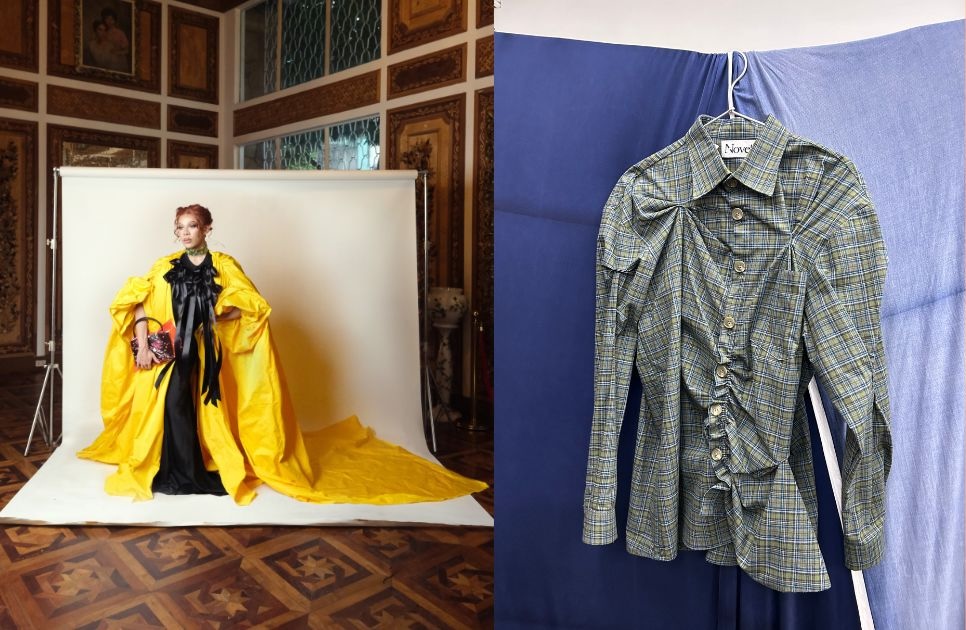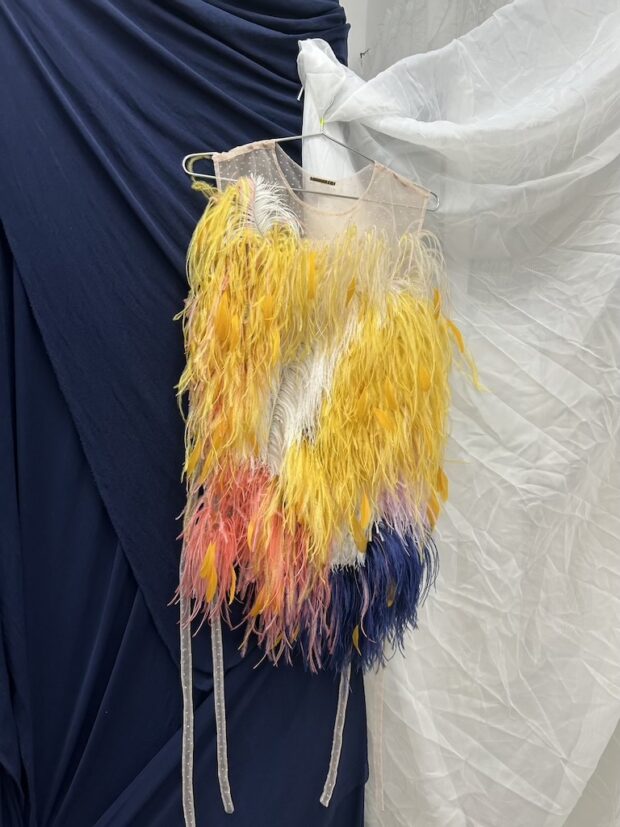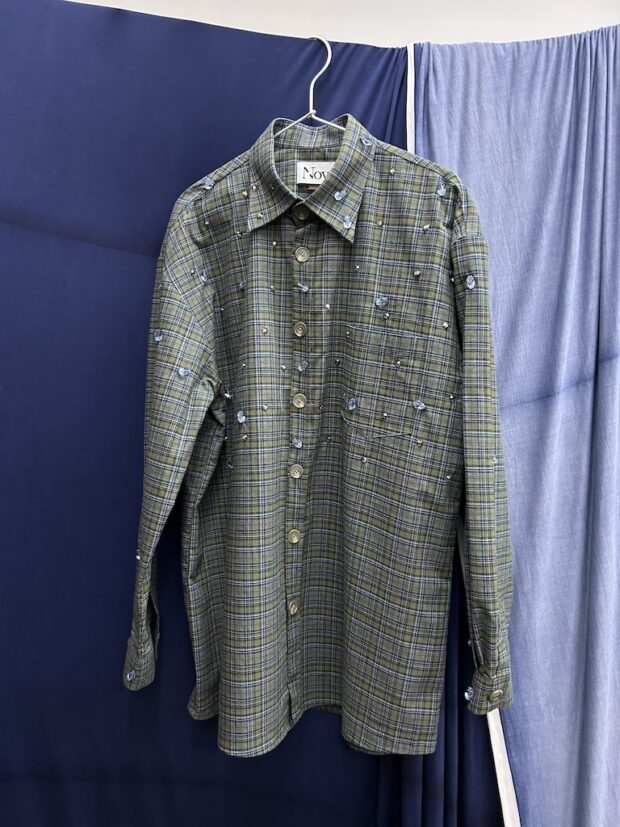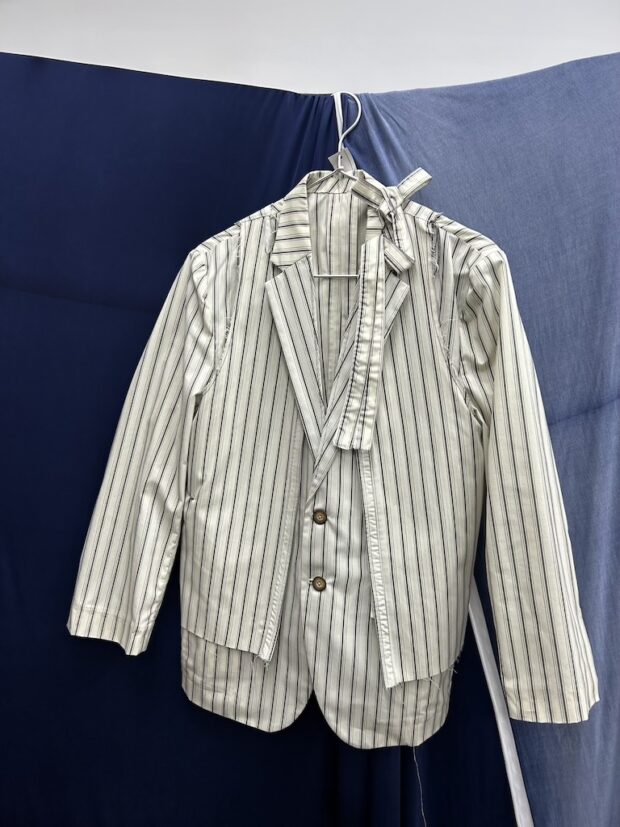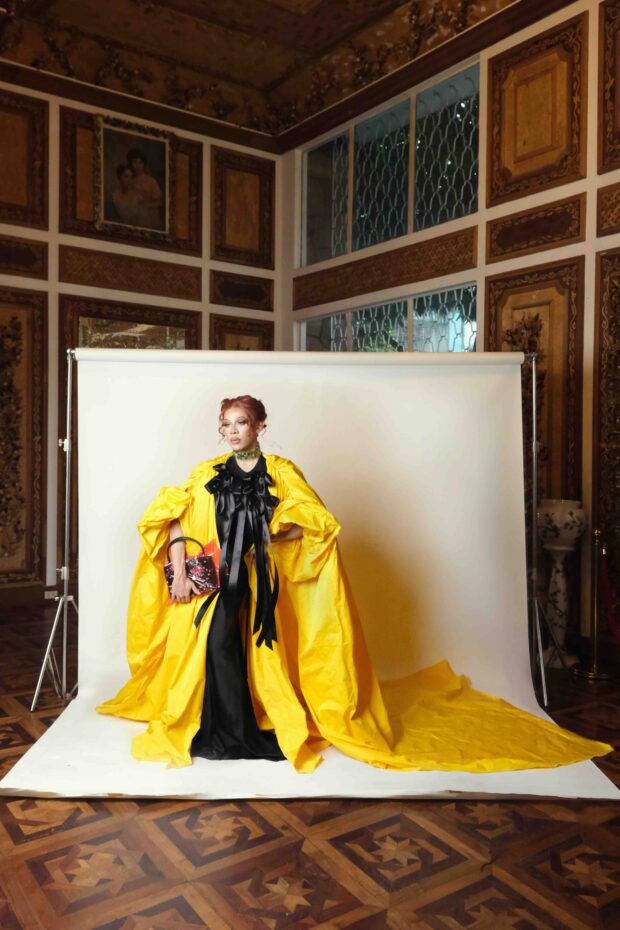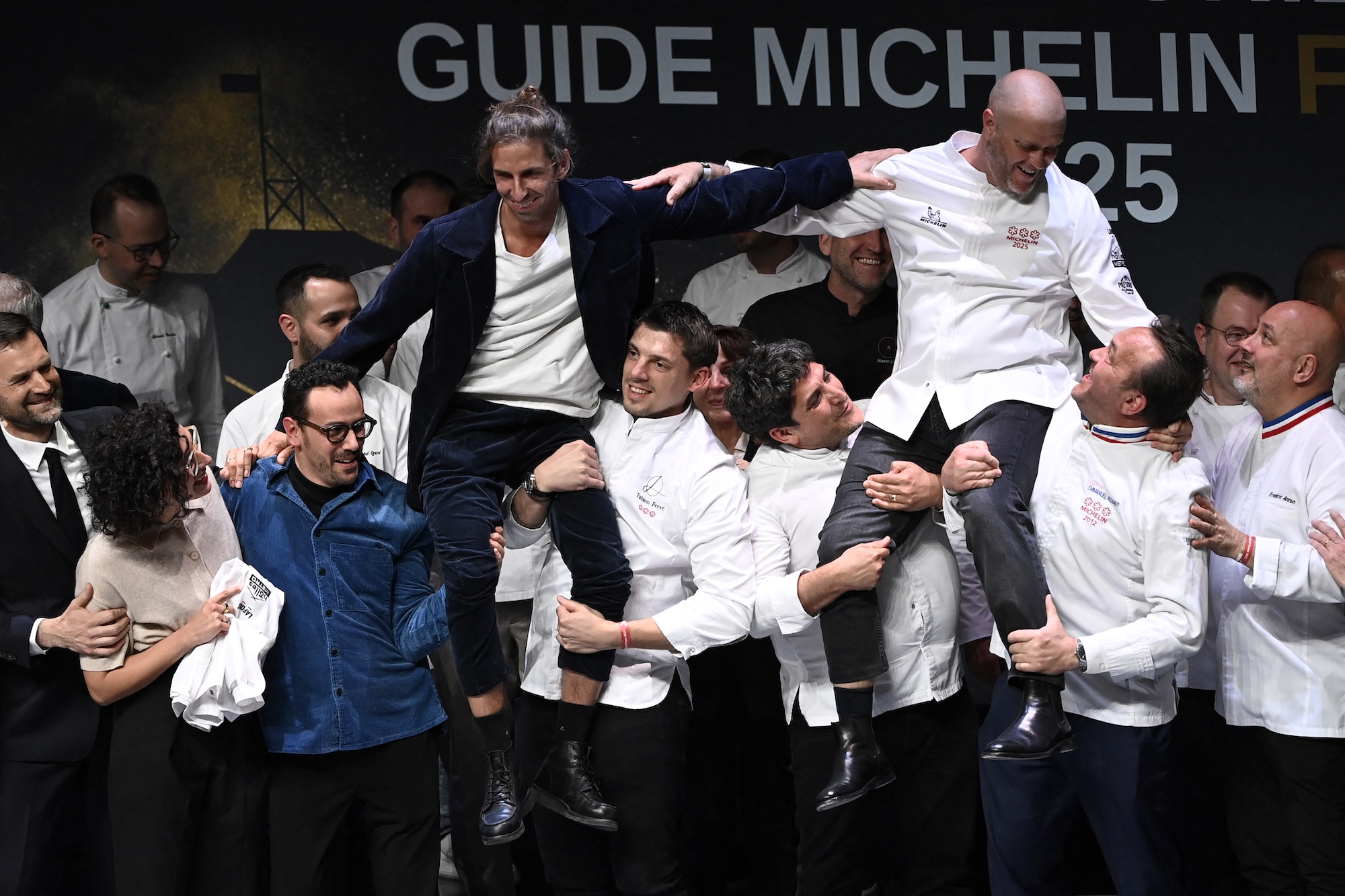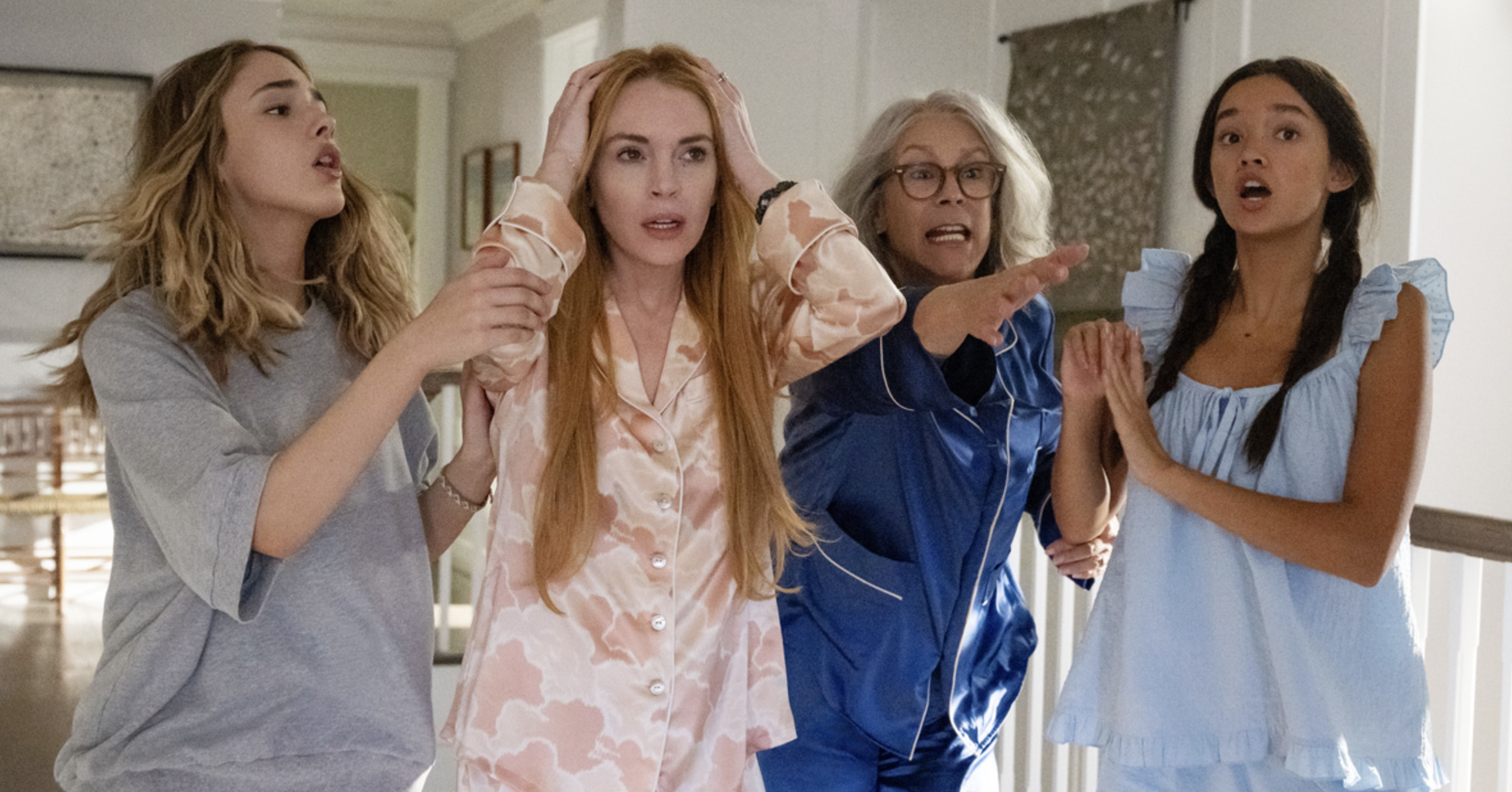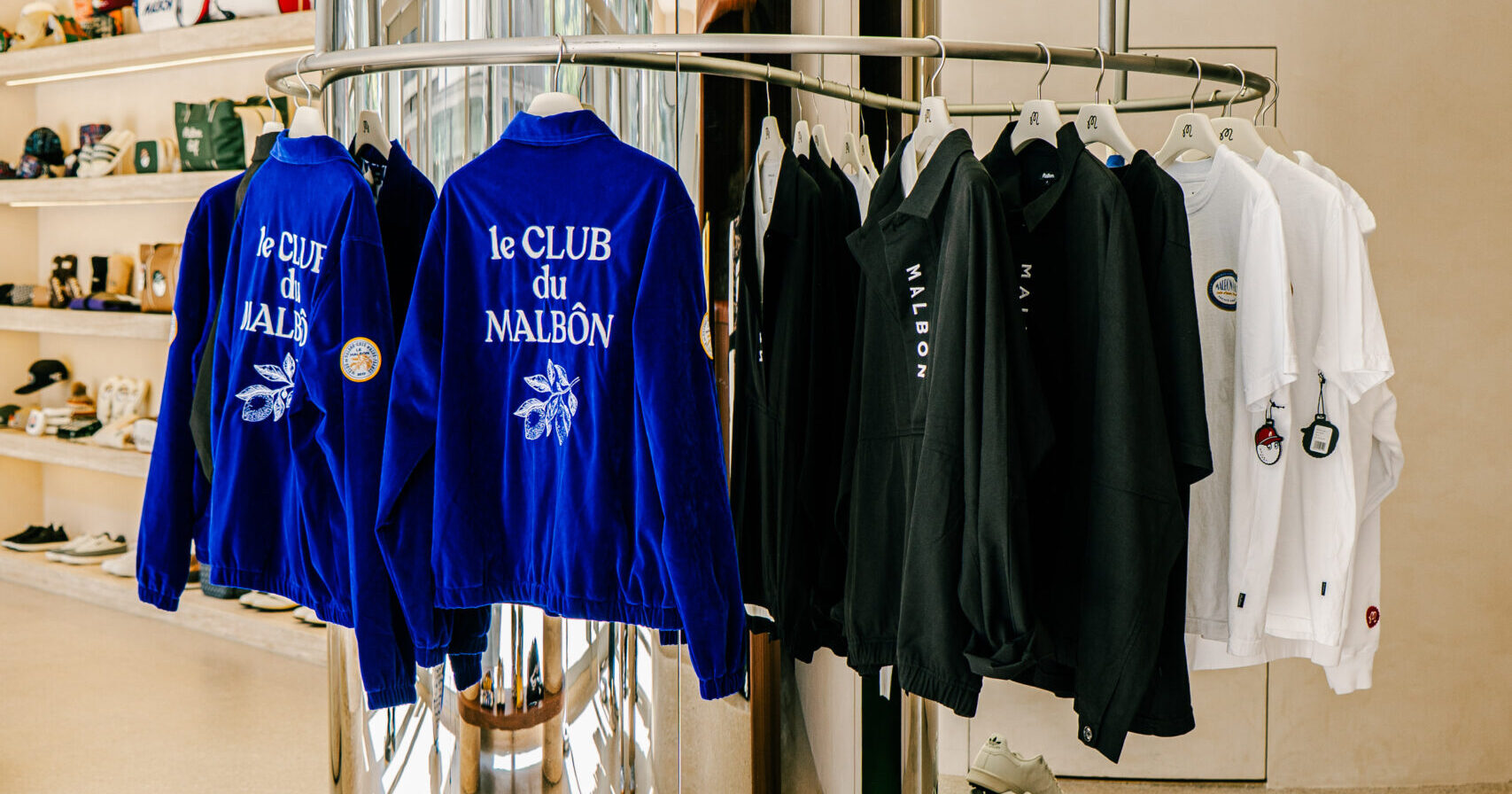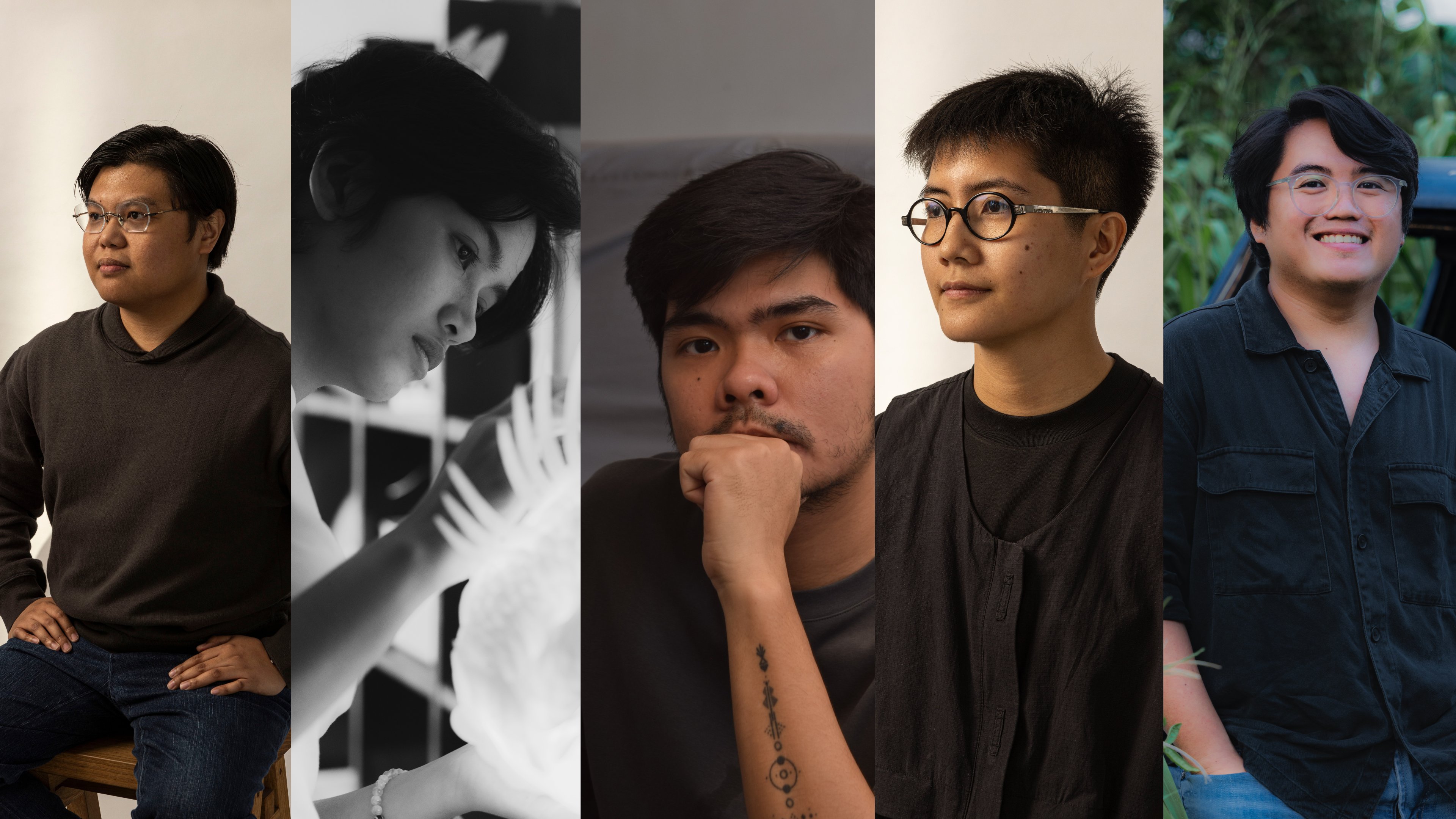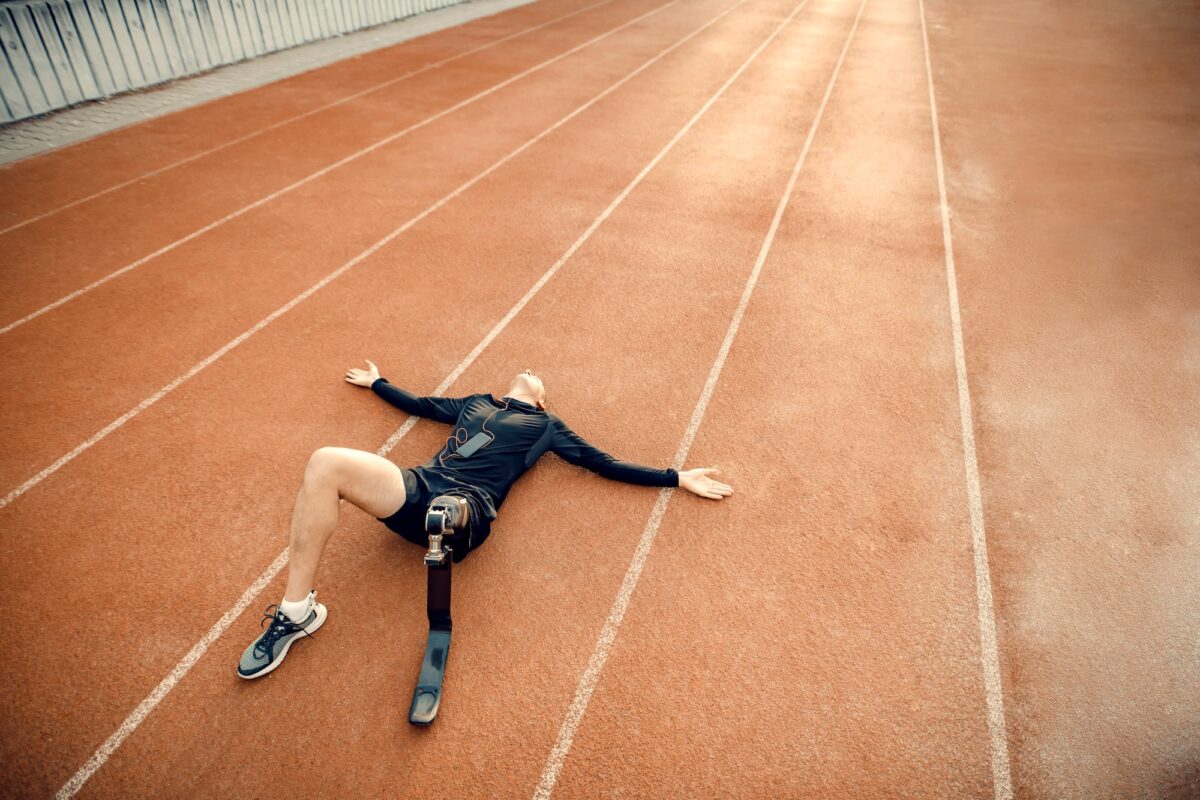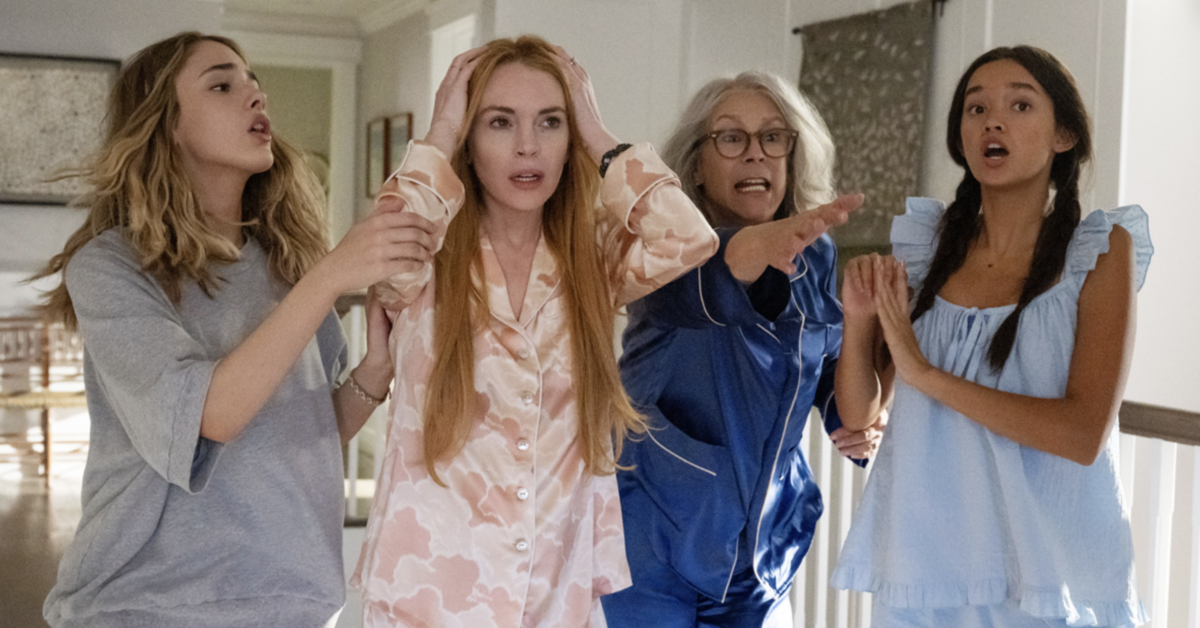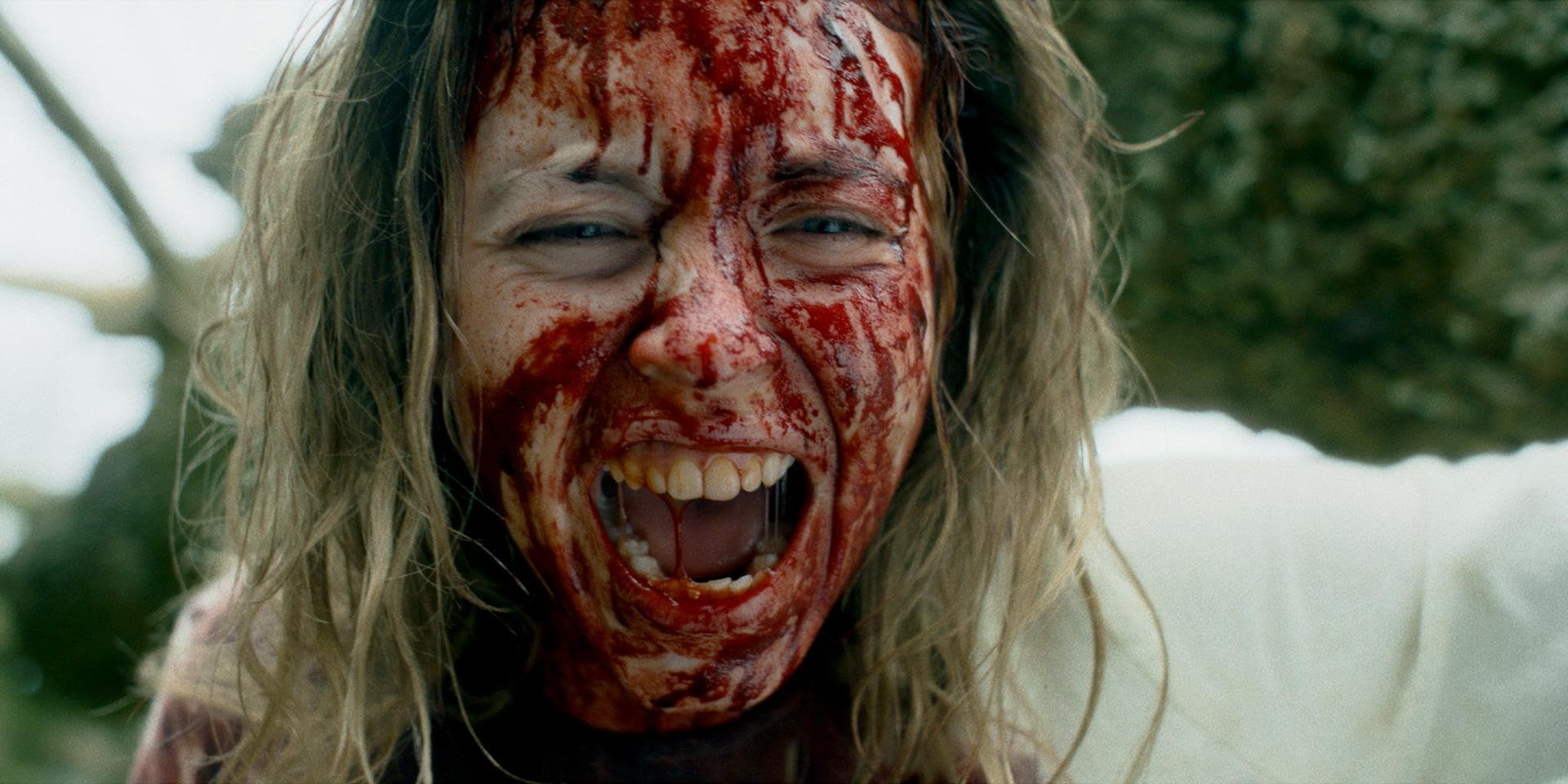The two designers talk about making T-shirts couture, forming connections with your clothes, living in delusion, and living vicariously though finsta
What happens when two designers with clashing styles—Jude Macasinag and Prince Padilla—walk through their collab collection at Guava Sketches? They find out that they actually have a lot in common.
Padilla, who’s behind Novel, rummages through a rack of his utilitarian future staples and pulls out a white short-sleeved shirt with a sash detail that detaches at the bottom. The couture-trained Macasinag is surprised. Pleasantly.
“I just realized we have similar elements with the sash,” says Macasinag.
To which Padilla says, “Oh my god, yeah! Yeah, we didn’t know that.”
“I had this idea of a pageant sash from my MA collection, but then I didn’t realize he also had the sash.”
“We’ve done a lot of panelings before, we’ve done ties and stuff. It’s quite synonymous with the brand (Novel), but so is this.”
If this were a catty fashion mockumentary, this is the part when the two of them quarrel, take down mannequins, and throw out clothes, both plain and intricately sewn, to the ground. But this is not it.
Macasinag and Padilla are good friends—despite their clashing, sometimes synchronous, design languages.
Padilla is wont to describe his garments as “pragmatic,” palliative compared to Macasinag’s in-your-face fashions, although he says he’s dialed it down a bit for this collection. Then again, his idea of dialing down is a skirt made of vintage mink fur, tulle tunics handstitched with peacock and ostrich feathers, a neon pink PVC stole, and ribbons—lots of them.
“These are silhouettes that are not as grand or as disruptive [compared] to how I usually use to make clothes,” says the designer who made an oversized ball gown with everyday Filipino blanket patterns for his graduate collection called “Haute Queer-ture” earlier this year.
In contrast, Novel pieces are more straightforward. Mostly menswear, his first foray amid being trained in it. Sturdy plaids and stripes with reasonable flourishes, a button-down with pinches that twist the garment in different parts to add shape, a two-piece suit sewn together that mysteriously fit most guests who tried it on.
“They’re quite easy to understand,” Padilla offers as an explanation. “I really didn’t want to be so cerebral about this collection. I just wanted to produce something that’s hopefully desirable and that people can just easily pick off, resonate with, and want to take home with them.”
Then there are the collab pieces. The same plaid shirting by Padilla is studded with Swarovski crystals by Macasinag. A microfaille trapeze vest consumed by a slither of double-faced ribbons, a valiant attempt by the couturier to introduce something “extra” to Novel’s otherwise grounded aesthetics.
T-shirts weighed down by more ribbons and cinchable by a grosgrain waist stay, stripped and pinched tees, and sensible shirting make up the duo’s ready-to-wear selection—a welcome deviation from the collab’s mostly one-off pieces.
“It’s the spirit of the one-off pieces into a more adaptable archetype,” says Macasinag.
“And commercial,” Padilla adds, “because we don’t have a problem saying it. It’s commercial. It is a T-shirt. Of course, we’re not always going to wear nice coats and jackets on the daily.”
In this conversation, the two designers talk about how their collaborative collection came about, why more disparate minds should come together, committing to a look, the necessity of living in delusion, why smaller designers also deserve your buck, and dishing out fashion criticism and taking it, too.
Can you tell us about how this collab came about?
Jude Macasinag (JM): We wanted to do something collaborative because it felt natural for us as friends, as co-designers because we also see each other pretty much eye to eye on a couple of things despite our work being polar opposites in several aspects.
Despite being polar opposites, why did you find it worthwhile to work together?
Prince Padilla (PP): A little bit of visual diversity, I think, in the actual garments themselves. It felt a lot more electric to do something that would clash together effectively.
JM: Clash or complement.
PP: To be able to offer more. Because at the end of the day, we want them to sell. Diversity is always good when you want to sell something because it allows people to have options.
We did have a conversation like, did we just want to exhibit clothes or did we want to exhibit and sell?
JM: That’s why the idea of the space is like a showroom but also it’s a shopping experience, hopefully. It’s also just nice as an idea that you have two designers whose work can look different, but then it works together quite well in the same space.
The show is called “Diasporic Studies,” I’m assuming because you two call two places home: Prince, London and Manila, and Jude, Paris and Manila. How has that shaped your design process?
PP: I was a lot more apologetic in what I could design, even as a fashion student. Because I think London is a boiling pot for unapologetic process, we are a lot more risk-takers. We’re encouraged to take risks in design.
But here, I’ve learned how to reduce and dilute some sensibilities in your work and to be able to belong in a community and for people to relate because you can’t design in a vacuum. Manila’s taught me how to not be so egotistical.
JM: [Living in Paris] opened me up in ways that sometimes contradict my preconceived notions: things that are very elitist like couture but then I’m also going to the dirtiest and grunchiest raves.
That sort of lived experience really shaped my visual language. But then I acknowledge and I emphasize still how I was born and raised in Manila.
In the three years that I was in the Bachelor and two years in the MA, I was the only Filipino design student there. It made me realize that I was able to achieve things, not necessarily because of where I came from, but in my own right.
I think it’s important that we acknowledge our own design values and the things that make it Filipino, but then we bring it into a scale that translates and is equally able to converse with the rest of the world.
What are your favorite pieces from the collection?
PP: [This two-in-one suit] just because it’s pretty. It’s just a top and a coat so you can’t take it off. You have to commit to the double layer.
JM: [For me,] it’s this silk taffeta coat. Very me, very grand. I really wanted this idea of just grabbing a piece of really nice fabric and then running around with it. Even the color is a commitment.
PP: You know, I always want to talk about commitment because a lot of these pieces do require a huge chunk of work.
JM: I think I sort of live in delusion also, which is good. For me, the way that I see fashion, it’s important nowadays, at least from my perspective, is to see it for the image.
So it’s always this idea of the dream, or maybe it’s not a dream, maybe it’s really just escapism or delusion but for me, it still matters.
PP: It’s a good contrast to how you look because I’m doing the opposite almost.
JM: He’s about reality. So again, it’s a good clash.
PP: Mine aren’t that dreamy. They’re very realistic and practical.
This is not the first time that you’ve worked with Guava Sketches. What are some of your learnings about how people buy? What are people looking for?
PP: Well, we’re in Manila so even just like something as mundane as climate, you have to adjust fabrication. A lot of people really respond to everyday wear.
JM: “A lot of people” and then there’s me with fur.
PP: A lot really respond to something that they can wear on more than one occasion. Clothes can’t be super situational, they have to have a versatile element to them. That’s what’s informed me to do more wearable stuff.
JM: It’s so different from the Parisian market, where the things that are appreciated here, sometimes it’s not as appreciated back in Paris. Even as simple as T-shirts, sometimes people would just look at it passively in Paris and not really appreciate it as a design product.
That’s actually also like why we continued this thing with Guava, because independent designers, they’re the future of the fashion design industry. Not everyone’s always going to have the same budget as more established designers. Not everyone’s going to have like perfect ateliers and perfect retail spaces in the higher-end malls. But then sometimes the work can be equally as good or equally as challenging or captivating to the design, for the creative community.
You talk a lot about the theatricality of garments or dressing up. So how do you personally go about picking something to wear on a regular day?
JM: Honestly, I’m someone who loves a T-shirt and jeans. But then that’s what makes it special because when I put a silk shirt on, I get to appreciate it more.
I don’t often plan my outfits as I used to, but for me dressing up on most days is still a performative act; the action of closing a button, you can find sensuality in that versus just using a snap or using a hook.
PP: Well, usually the clothes pick me. I usually just pick out what’s on the rack. This is where we’re polar opposites. I mean I have a visual of what it looks like. I don’t think about it all the time. You don’t overthink it like that.
What do you do when you’re not making clothes?
PP: Sleep.
JM: Eat. I tried for like a month after my MA collection to not do anything. I was really refraining from doing anything fashion-related or sewing-related for a month because it also takes a physical toll on us.
The things that you do when you’re not sewing, do you think of it as like, ‘Oh, I’m doing this because it might inform my work’? Because sometimes that is something that I do.
PP: I don’t wake up with the intention but ultimately it does. It’s difficult to not let everything else sort of trickle down into your work. Especially something as material as fashion.
Outside of fashion, what’s something you’re obsessed with right now?
PP: I play a lot of video games. RPGs. ‘Diablo 4,’ ‘Final Fantasy.’ I’m a big ‘Final Fantasy’ fan. I make time to play video games because I can always be sewing. It’s something you really have to force yourself to ‘Okay, I’m gonna stop. I’m gonna entertain myself for a while.’
But I’ve not been video gaming lately. I’ve been sleeping in the studio actually.
Is that bad?
PP: No, it’s great. But it’s a different environment.
JM: Do you like to separate your working and your leisure spaces? Because I do.
PP: No.
JM: For me, it’s important to not have a sewing machine where I sleep. My studio in Paris is 18 square meters. But I make sure that the sewing machine stays on the table and that there are no clothes that I stitch on the bed.
JP: I can. Basically, I’m the opposite. I guess I’m that integrated. I can literally sleep next to the sewing machine.
Jude, what are you obsessed with right now that’s not fashion?
JM: I actually don’t know what to answer. It’s so pretentious to say but I feel like a lot of things that I revolve around are very relevant to fashion. But because, again, fashion for me, it’s not just about clothing. It’s about a certain creative universe, it’s about building identity. So maybe that’s why I’m not able to separate fashion from my life now in that sense. My fandom is fashion basically.
PP: I mean, you went on vacation to Greece. It was nice just to see him on a break.
JM: I was still dealing with pull-outs. I was still emailing. I like to hang out with friends. For me, that’s the best way of having a life outside of fashion.
Anything else you want to talk about?
JM: We had a call wherein we were talking about how we see each other’s works and how we would critique it. There were times when Prince would tell me, ‘Hey, do more less time-consuming, less couture things.’ And I wouldn’t take it personally because, for me, it’s just healthy to have that sort of dialogue. And I feel like that’s something that we need to have more of in the Philippines.
PP: To be open to criticism.
JM: And to critique others responsibly and helpfully.
PP: And to respond in a healthy way, too. I think more on the response actually because a lot of us critique already.
JM: If we’re gonna talk sh*t about someone, talk sh*t about them in their face. I’m kidding.
How often do you call each other?
PP: We chat daily in the weeks, months [before this show].
JM: Or even just like talking about other things. Prince is on the Finsta so he sees more than enough.

